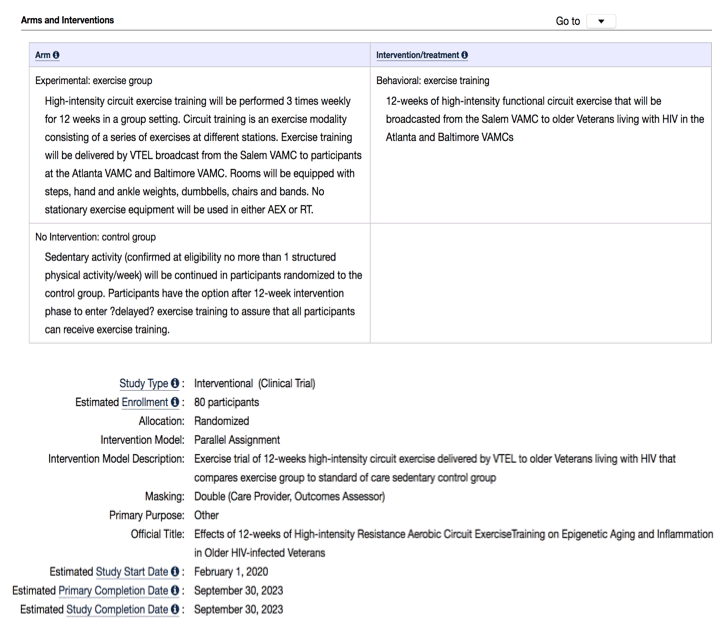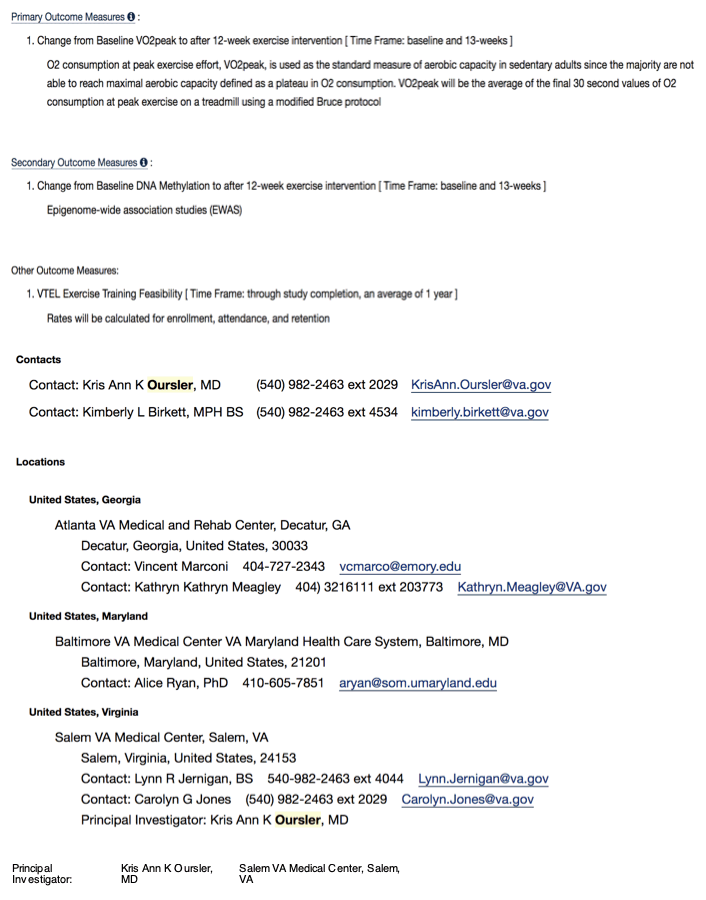| |
Functional Interval Training for Veterans Exercising Through Telehealth. (FIT-VET)
|
| |
| |
https://clinicaltrials.gov/ct2/show/NCT04103593?term=oursler&rank=2
Sponsor:
VA Office of Research and Development
Collaborators:
Atlanta VA Medical Center
Baltimore VA Medical Center
Information provided by (Responsible Party):
VA Office of Research and Development
Brief Summary:
Most Veterans living with HIV are 50 years of age or older and can expect to live more than 20 years longer with HIV medication. However, despite this success, Veterans living with HIV are more likely to have age-related diseases and loss of fitness and muscle that place them at increased risk for disability. This is a major priority for the VHA, the largest provider of HIV care in the United States. The goal of this study is to test a circuit exercise program in Veterans living with HIV that is designed to slowdown the aging process. The exercise program will be widely available by Video Teleconferencing (VTEL) and does not require stationary exercise equipment, making it widely accessible. This research will help reach the goal for Veterans to preserve their quality of life and ability to function independently. Novel findings will strengthen strategies to maintain life-long fitness through a personalized exercise prescription.
Detailed Description:
The Veterans Health Administration (VHA) is the largest U.S. HIV health provider with 64% of these Veterans 50+ years of age. HIV infection in the setting of antiretroviral therapy represents a chronic disease with an advanced aging phenotype manifested as increased cardiovascular disease, sarcopenia, and frailty, primarily driven by systemic inflammation. The investigators found a 42% reduction in VO2peak in older HIV+ adults that significantly improved with high-intensity aerobic (AEX) and resistance training (RT). Yet, durable strategies for high-intensity exercise in older adults remain a challenge and limited data are available in older HIV+ adults. There is an urgent need to address these knowledge gaps in order to prevent widespread disability in HIV+ Veterans. The objective is to provide a high-intensity exercise program for older Veterans that can be widely disseminated and attenuates processes underlying aging. Epigenetic changes with increased age encapsulate the putative effects of biological aging and lifestyle factors. DNA methylation (DNAm) patterns are frequently modified in genes encoding pro-inflammatory cytokines, but can be reversed with exercise training. DNA methylation age (DNAm Age) is an epigenetic biomarker that is expressed in years and provides a concrete benchmark of advanced aging. The investigators found that HIV+ adults have DNAm Age 11 years greater than age-matched adults without HIV. Further, in adults without HIV, increased DNAm Age is associated with physical inactivity, weakness and frailty. Preliminary data in the Veterans Aging Cohort Study (VACS) show that DNAm Age correlates with the VACS Index, a measure of frailty in HIV+ adults. However, the impact of exercise training on DNAm Age has yet to be determined in any patient population. The investigators propose to adapt center-based high-intensity AEX+RT intervention in older HIV+ Veterans into a video telehealth (VTEL) delivered functional (no stationary equipment) exercise program that leverages epigenetic outcomes to demonstrate anti-aging effects of exercise. The overarching hypothesis is that VTEL high-intensity functional circuit exercise in older HIV+ Veterans will improve the advanced aging phenotype and attenuate DNAm epigenetic processes underlying aging. Experimental approach includes a 12-week VTEL exercise intervention in 80 older HIV+ Veterans who are randomized to exercise or standard of care sedentary control groups. AIM 1 will determine the effect of VTEL exercise on VO2peak, sarcopenia, and frailty as phenotypic outcomes of advanced aging in HIV. AIM 2 will investigate the effect of VTEL exercise on DNAm Age as a biomarker of advanced aging. AIM 3 will determine the effect of VTEL exercise on DNA methylation of specific genes encoding specific pro-inflammatory cytokines in leukocytes. This approach will advance an understanding of effective and feasible exercise strategies to prevent and minimize disability in patient populations with advanced aging. Findings will provide an innovative approach to functional exercise in all older adults. DNAm Age could be used as a personalized benchmark for an individual's benefit from exercise to promote sustainable behavior change. Findings will also provide epigenetic risk profiles that can be used to generate a personalized exercise prescription, an important next step in the next decade of precision medicine. The proposal leverages exercise training experience in HIV and VTEL, availability of 3,000 HIV+ Veterans at Atlanta and Baltimore VAMCs, and the VHA VTEL infrastructure. The capacity to disseminate VTEL exercise with minimal cost using existing infrastructure will facilitate large-scale dissemination and national impact. Deliverables include improved clinical outcomes and substantial cost savings from reduced hospitalization and institutionalization rates.


|
|
| |
| |
|
|
|